FiiO E17 Alpen Portable Amplifier / DAC Review
FiiO is a young Chinese company, founded in 2007, nevertheless, it is already well-known throughout the world, in particular, in Ukraine. Engaged in the development of portable amplifiers, DACs. Also in its arsenal has several fixed devices. As you may have guessed from the title, today we will focus on a portable amplifier with a built-in DAC - FiiO E17.

Attention! I am not an audiophile, not an audiophile at all. I can distinguish the sound quality, but I can not describe it, so do not expect me to clarify its quality. In fact, this is more a review of the "piece of hardware" than a headphone amplifier.
FiiO E17 features:
The device rode from China exactly 9 days. Postal service - EMS. Everything arrived safe and sound.

We begin to unpack and find the product catalog. The young Chinese company has more than 20 products, which is a bit impressive.
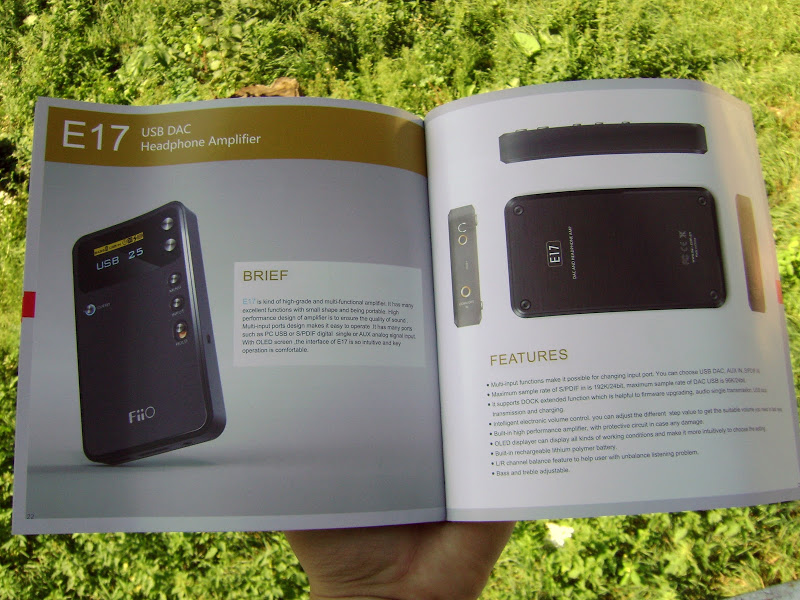
We reach the device itself, it is packed in a neat cardboard box.

Inside which we find a canvas bag with FiiO E17 inside, instruction manual,
USB cable, Toslink adapter -> mini Toslink, mini-jack adapter 3.5 mm -> RCA, mini-jack mini-jack audio cable (3.5 mm), two-piece protective film for the front panel, as well as a silicone ring for fixing the amplifier and self-adhesive legs for fixed placement.


As you can see, the package bundle is rich in various “baubles”, the main drawback is the lack of a networked charger, because there isn’t always a USB port for charging. There are still minor flaws, but about them under the heading "Operation and autonomy."
The body of the gadget consists entirely of black anodized aluminum. The display is covered with plastic, which is very easy to scratch. The design itself leaves the impression of a brutal piece of metal, which should appeal to the masculine.
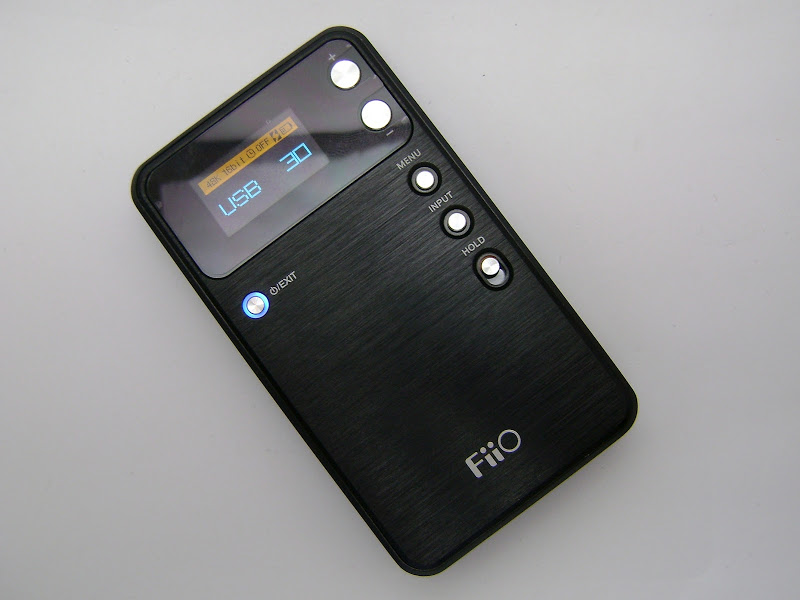
Almost all controls, with the exception of the LO BYPASS switch, are on the front panel. On the left, the power button was lonely sheltered, a long press of which (about 3 seconds) turns on the device, it is framed by a backlight ring having three modes of illumination:
 The ring is lit in blue - the device is turned on and functioning.
The ring is lit in blue - the device is turned on and functioning.
 The red light is on - the device is charging.
The red light is on - the device is charging.
 With the glow of red and blue, we get something similar to the color purple, which means - the device is working and charging at the same time.
With the glow of red and blue, we get something similar to the color purple, which means - the device is working and charging at the same time.
On the right there are 5 controls, we’ll go all the way from top to bottom:
')
All the inscriptions, apparently, are made by laser engraving, it tells us about their durability.
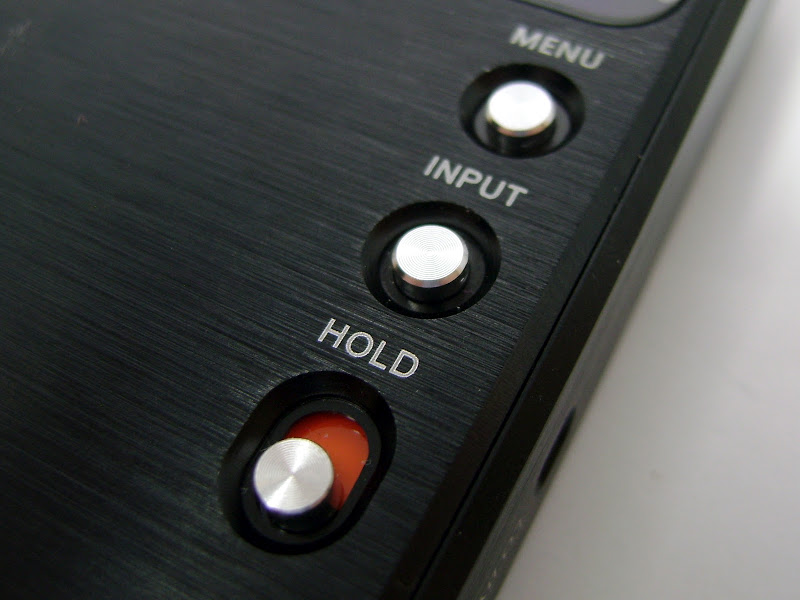
Next in line are the connectors. Let's start from the bottom. From left to right: a mini USB, a proprietary docking connector for installation in the FiiO E9 socket and an input connector for receiving an analog audio signal.
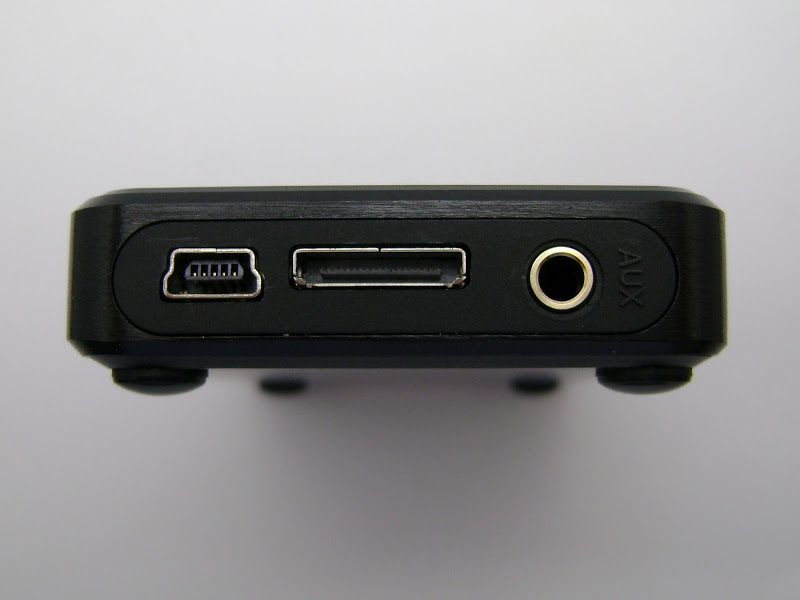
At the top there are: S / PDIF input, reset button and headphone output.
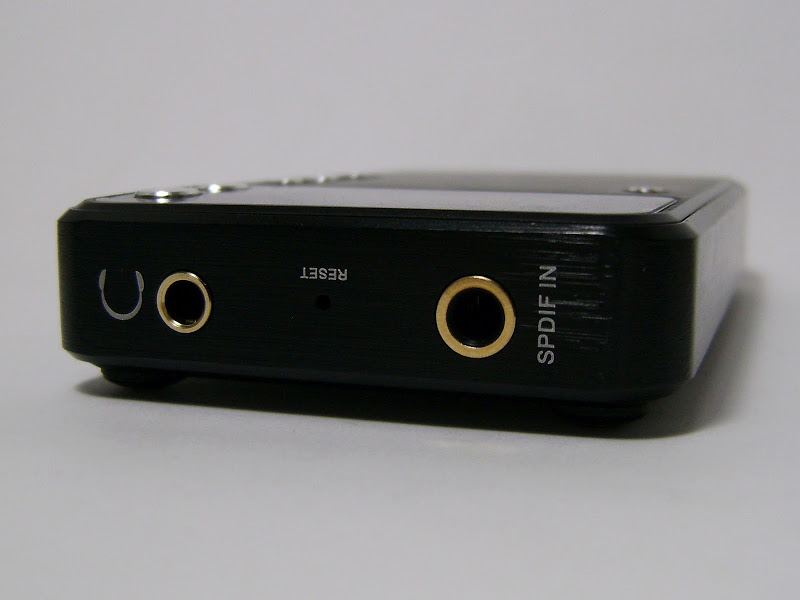
The design is good, from the minuses only that dust is clogged in the joints between the parts of the case, and the front panel is pressed a little.
The device is equipped with a small two-color OLED display. The main advantage of this solution is the excellent behavior of the display in the sun and its low power consumption.
The interface here is simpler than a steamed turnip; more precisely, it cannot even be called an interface. Depending on the audio source, of which there are four (USB, AUX, OPT, COX), the main screen looks like this:




The top row displays information about the incoming audio signal, the off timer, the charge indicator, the battery level, and the volume level.
The menu has 9 items of various settings.



On the first three points, everything is standard, adjusting the high, low and balance.



The point at which you can adjust the gain of the signal is 0, 6 and 12 dB.

It is possible to disable charging from USB:

SLEEP mode, allows you to set the time (from 10 to 90 minutes), after which the device turns off.



The next item MAX VOLUME allows you to set the maximum volume from 20 to 60.


VOLUME MEM - memorization of the last set volume.

And finally, SYSTEM SET has two subitems FW VERSION and DEFAULT SET, which respectively mean the firmware version and default settings.


The interface is simple and convenient, no complaints, but with a good display, everything is just fine.
The device is disassembled by unscrewing the four screws at the corners of the back cover.

After removing the cover, we see the battery, which, judging by the dimensions, corresponds to the stated 1.5 A * h.
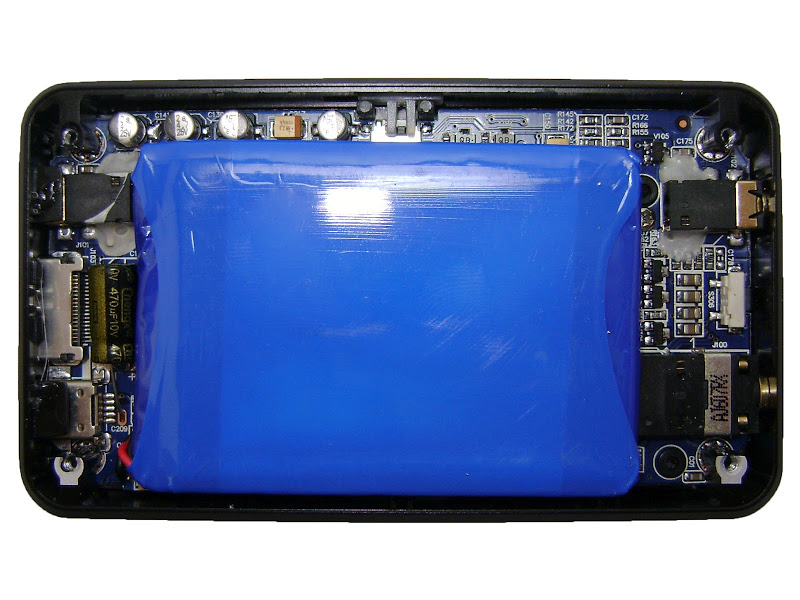
The battery "sits" on a double-sided tape, and under it the actual charge. Element base - elementary. :)
The device steers an 8-bit STM8S105K6T6C stone, as a WM8804 DAC, the rest is in the photo below.
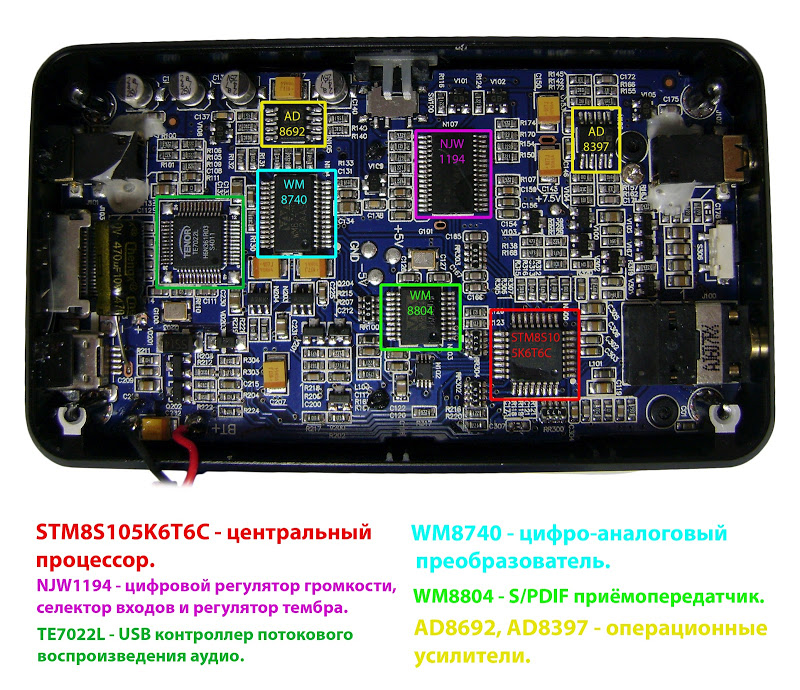
The soldering is of high quality, the flux is washed off, the connectors are additionally secured by some kind of compound. Inside, everything is fine.
As I said, I am not an audiophile, but I could still appreciate the sound. For testing, I had to ask a friend for more or less decent headphones, or rather, a Grado SR60i. The device can be used in 4 modes. In the absence of devices with a coaxial / optical output, I will only talk about using the E17 as an external sound card and an amplifier for “headphones”.
Here the device proved itself from the best side. The fact is that my computer has been out for more than one year and during this time the audio output connector has become rather loose, the cable began to move because of what the sound simply became unbearable. Thanks to this device managed to get rid of various interferences, as well as improve the sound quality. Believe me, even I noticed the difference, music from porridge turned into distinct sounds of various instruments. In each barrel of honey, as you know, there is a spoon of tar. And here it didn’t go without it - the ease of use was disappointing. But more about this rubric below.
I will say straight - not impressed. I will describe my impressions with a single quote from a very popular forum dedicated to personal audio: “If you increase the shit, you will end up with increased shit”. In this case, the sound source was the Nokia X3-00. Of course, the volume margin appeared, and even some, but the sound quality remained at the same level.
If you use FiiO E17 as a headphone amplifier, then only with a phone / player who can play lossless and high-impedance headphones. Then it will be a matter of him, since your phone is unlikely to "shake" 300-ohm headphones, and baby FiiO will cope with this task without problems.
Perhaps the E17 is more suitable for owners of Apple, Sony or SanDisk mobile devices. Indeed, in the arsenal of FiiO there are special LOD-cables, with the help of which you can get sound around the standard amplifier. It would be very interesting to test this mode, but I don’t know Apple technology ...
The sound is not the slightest claim, only delight, but on condition of using the device in the DAC mode or in the presence of a high-quality signal source.
Convenience of operation has pumped up that in portable that in stationary use. In the case of using the phone with a phone, you get a sandwich that does not fit into any pocket anymore. In a bag or backpack - no problem, but tell me, are many of you carrying a phone / player in a bag or backpack? In the case of a call to the phone, it will be extremely difficult to answer. And if it does happen, during a conversation you will look like an idiot who is standing in the headphones, holding a sandwich from the phone and the amplifier in front of him and actually speaks into it. Submitted? Laughed at Go ahead.
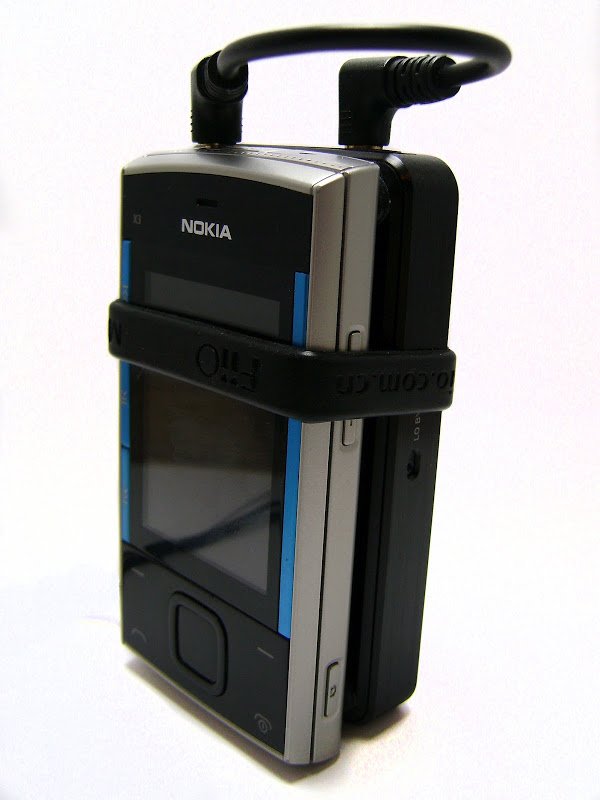
When used as an external PC sound card, the disappointment lies in the incomprehensible operation of the power subsystem. Suppose I connected the FiiO E17 to a PC, turned off the battery charge mode and turned the HOLD lever to the lower position. I listened to the whole evening, and then left it for the night, turned on with the computer. In the morning it is already off. How so? If I turned off the battery charge mode, then the idea was that the device should switch to USB power. No matter how, that very point in me called “USB CHG” does not put the device into USB mode, it just turns off the possibility of charging the battery, but why? To reduce interference from the charge circuit? Fortunately, I did not notice those, but now I have to turn off the device itself with the computer, otherwise the battery sits down overnight and without a small charge in the morning the device simply refuses to turn on.
About autonomy. In the mode of continuous listening to music, the device worked for an average of 13 hours against the stated fifteen. Charging time at 3.5 hours. With autonomy, everything is fine, the charge will suffice both in the case of the urban mode of use, and in the case of the near trip.
The FiiO E17 Alpen is a portable headphone amplifier with a DAC function that successfully combines a stylish design with minimal dimensions and excellent sound quality. Unfortunately, the device has been identified and disadvantages. But given the cost of 170 evergreens, these shortcomings can be neglected.
+ rich equipment
+ case material, design
+ high-quality OLED display
+ simple and convenient interface
+ sound quality (subject to quality source or use of a DAC)
+ autonomy
+ price
- uselessness of the device in the amplifier mode, if you use a non-high-quality signal source
- incomprehensible operation of the power subsystem in a stationary mode of use
If you do not have an account on Habrahabr, you can read and comment on our articles on BoxOverview.com

Attention! I am not an audiophile, not an audiophile at all. I can distinguish the sound quality, but I can not describe it, so do not expect me to clarify its quality. In fact, this is more a review of the "piece of hardware" than a headphone amplifier.
FiiO E17 features:
- Output power:> 250mW (load 16Ω); > 30mW (load 300Ω)
- Load resistance range: 16 Ω ~ 300 Ω
- Signal to noise ratio (amplifier): ≥109dB
- Signal to Noise Ratio (D / A): ≥104dB
- Distortion (amplifier): <0.001% (10 mW)
- Distortion (DAC): <0.007% (10 mW)
- Maximum USB sampling rate: max. 96 kHz / 24 bit
- Maximum sampling rate SPDIF: max. 192 kHz / 24 bit
- Frequency range (amplifier): 10 Hz - 100 kHz
- Frequency range (DAC): 10 Hz - 20 kHz
- Built-in Li-ion battery, capacity: 1.5 Ah
- Charging via USB, charge time: 3.5 hours
- Continuous operation time: up to 15 hours
- Dimensions: 96 x 55 x 15.5 mm
- Weight: 112g
Delivery, equipment
The device rode from China exactly 9 days. Postal service - EMS. Everything arrived safe and sound.

We begin to unpack and find the product catalog. The young Chinese company has more than 20 products, which is a bit impressive.

We reach the device itself, it is packed in a neat cardboard box.

Inside which we find a canvas bag with FiiO E17 inside, instruction manual,
USB cable, Toslink adapter -> mini Toslink, mini-jack adapter 3.5 mm -> RCA, mini-jack mini-jack audio cable (3.5 mm), two-piece protective film for the front panel, as well as a silicone ring for fixing the amplifier and self-adhesive legs for fixed placement.


As you can see, the package bundle is rich in various “baubles”, the main drawback is the lack of a networked charger, because there isn’t always a USB port for charging. There are still minor flaws, but about them under the heading "Operation and autonomy."
Appearance and controls
The body of the gadget consists entirely of black anodized aluminum. The display is covered with plastic, which is very easy to scratch. The design itself leaves the impression of a brutal piece of metal, which should appeal to the masculine.

Almost all controls, with the exception of the LO BYPASS switch, are on the front panel. On the left, the power button was lonely sheltered, a long press of which (about 3 seconds) turns on the device, it is framed by a backlight ring having three modes of illumination:
 The ring is lit in blue - the device is turned on and functioning.
The ring is lit in blue - the device is turned on and functioning. The red light is on - the device is charging.
The red light is on - the device is charging. With the glow of red and blue, we get something similar to the color purple, which means - the device is working and charging at the same time.
With the glow of red and blue, we get something similar to the color purple, which means - the device is working and charging at the same time.On the right there are 5 controls, we’ll go all the way from top to bottom:
')
- Volume buttons, part-time up and down buttons in the menu.
- The MENU button also functions as an “OK” button.
- INPUT button - input selector.
- HOLD lever - in the lower position locks all other buttons.
All the inscriptions, apparently, are made by laser engraving, it tells us about their durability.

Next in line are the connectors. Let's start from the bottom. From left to right: a mini USB, a proprietary docking connector for installation in the FiiO E9 socket and an input connector for receiving an analog audio signal.

At the top there are: S / PDIF input, reset button and headphone output.

The design is good, from the minuses only that dust is clogged in the joints between the parts of the case, and the front panel is pressed a little.
Display and interface
The device is equipped with a small two-color OLED display. The main advantage of this solution is the excellent behavior of the display in the sun and its low power consumption.
The interface here is simpler than a steamed turnip; more precisely, it cannot even be called an interface. Depending on the audio source, of which there are four (USB, AUX, OPT, COX), the main screen looks like this:




The top row displays information about the incoming audio signal, the off timer, the charge indicator, the battery level, and the volume level.
The menu has 9 items of various settings.



On the first three points, everything is standard, adjusting the high, low and balance.



The point at which you can adjust the gain of the signal is 0, 6 and 12 dB.

It is possible to disable charging from USB:

SLEEP mode, allows you to set the time (from 10 to 90 minutes), after which the device turns off.



The next item MAX VOLUME allows you to set the maximum volume from 20 to 60.


VOLUME MEM - memorization of the last set volume.

And finally, SYSTEM SET has two subitems FW VERSION and DEFAULT SET, which respectively mean the firmware version and default settings.


The interface is simple and convenient, no complaints, but with a good display, everything is just fine.
Interiors, element base
The device is disassembled by unscrewing the four screws at the corners of the back cover.

After removing the cover, we see the battery, which, judging by the dimensions, corresponds to the stated 1.5 A * h.

The battery "sits" on a double-sided tape, and under it the actual charge. Element base - elementary. :)
The device steers an 8-bit STM8S105K6T6C stone, as a WM8804 DAC, the rest is in the photo below.

The soldering is of high quality, the flux is washed off, the connectors are additionally secured by some kind of compound. Inside, everything is fine.
Sound
As I said, I am not an audiophile, but I could still appreciate the sound. For testing, I had to ask a friend for more or less decent headphones, or rather, a Grado SR60i. The device can be used in 4 modes. In the absence of devices with a coaxial / optical output, I will only talk about using the E17 as an external sound card and an amplifier for “headphones”.
Use as an external sound card
Here the device proved itself from the best side. The fact is that my computer has been out for more than one year and during this time the audio output connector has become rather loose, the cable began to move because of what the sound simply became unbearable. Thanks to this device managed to get rid of various interferences, as well as improve the sound quality. Believe me, even I noticed the difference, music from porridge turned into distinct sounds of various instruments. In each barrel of honey, as you know, there is a spoon of tar. And here it didn’t go without it - the ease of use was disappointing. But more about this rubric below.
Use as headphone amplifier
I will say straight - not impressed. I will describe my impressions with a single quote from a very popular forum dedicated to personal audio: “If you increase the shit, you will end up with increased shit”. In this case, the sound source was the Nokia X3-00. Of course, the volume margin appeared, and even some, but the sound quality remained at the same level.
If you use FiiO E17 as a headphone amplifier, then only with a phone / player who can play lossless and high-impedance headphones. Then it will be a matter of him, since your phone is unlikely to "shake" 300-ohm headphones, and baby FiiO will cope with this task without problems.
Perhaps the E17 is more suitable for owners of Apple, Sony or SanDisk mobile devices. Indeed, in the arsenal of FiiO there are special LOD-cables, with the help of which you can get sound around the standard amplifier. It would be very interesting to test this mode, but I don’t know Apple technology ...
The sound is not the slightest claim, only delight, but on condition of using the device in the DAC mode or in the presence of a high-quality signal source.
Operation and autonomy
Convenience of operation has pumped up that in portable that in stationary use. In the case of using the phone with a phone, you get a sandwich that does not fit into any pocket anymore. In a bag or backpack - no problem, but tell me, are many of you carrying a phone / player in a bag or backpack? In the case of a call to the phone, it will be extremely difficult to answer. And if it does happen, during a conversation you will look like an idiot who is standing in the headphones, holding a sandwich from the phone and the amplifier in front of him and actually speaks into it. Submitted? Laughed at Go ahead.

When used as an external PC sound card, the disappointment lies in the incomprehensible operation of the power subsystem. Suppose I connected the FiiO E17 to a PC, turned off the battery charge mode and turned the HOLD lever to the lower position. I listened to the whole evening, and then left it for the night, turned on with the computer. In the morning it is already off. How so? If I turned off the battery charge mode, then the idea was that the device should switch to USB power. No matter how, that very point in me called “USB CHG” does not put the device into USB mode, it just turns off the possibility of charging the battery, but why? To reduce interference from the charge circuit? Fortunately, I did not notice those, but now I have to turn off the device itself with the computer, otherwise the battery sits down overnight and without a small charge in the morning the device simply refuses to turn on.
About autonomy. In the mode of continuous listening to music, the device worked for an average of 13 hours against the stated fifteen. Charging time at 3.5 hours. With autonomy, everything is fine, the charge will suffice both in the case of the urban mode of use, and in the case of the near trip.
Results
The FiiO E17 Alpen is a portable headphone amplifier with a DAC function that successfully combines a stylish design with minimal dimensions and excellent sound quality. Unfortunately, the device has been identified and disadvantages. But given the cost of 170 evergreens, these shortcomings can be neglected.
Liked
+ rich equipment
+ case material, design
+ high-quality OLED display
+ simple and convenient interface
+ sound quality (subject to quality source or use of a DAC)
+ autonomy
+ price
Did not like
- uselessness of the device in the amplifier mode, if you use a non-high-quality signal source
- incomprehensible operation of the power subsystem in a stationary mode of use
If you do not have an account on Habrahabr, you can read and comment on our articles on BoxOverview.com
Source: https://habr.com/ru/post/152557/
All Articles